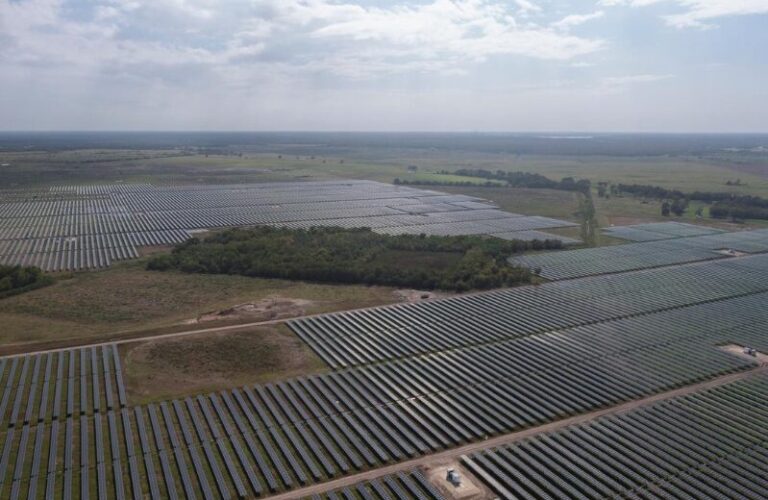In a press release issued the same day, Ørsted said its Board of Directors had approved amendments to its business plan, which included plans to cut capital investment spending, following what Errboe described as a “challenging year for the [renewables] industry”.
The decision to co-locate a BESS with an operational generation facility follows a similar strategy adopted by the UK development arm of Ørsted, after it announced plans to co-locate a 300MW/600MWh storage facility with an offshore wind farm at the site of an onshore substation in Norfolk, as reported by Energy-Storage.news towards the end of last year.
US$135 million investment for 500MWh BESS
As stated in its annual report, Ørsted decided to move forward with its Old 300 BESS project during the final quarter of 2024 and hopes to commence construction on the development before the end of this quarter.
The 250MW/500MWh BESS will be co-located with the company’s operational Old 300 Solar Energy Center encompassing 16 acres of land approximately 3.6 miles south of Needville in Fort Bend County.
Last year, Ørsted completed construction on the final 73MWac portion of its Old 300 Solar project, bringing the total solar generation at the site up to 430MWac. As reported by sister site PV-Tech, Ørsted entered into an agreement with Microsoft during 2021, whereby the multinational technology company would purchase energy from the solar portion of Old 300.
Ørsted holds a tax abatement agreement with Fort Bend County through its Old 300 Storage Center, LLC business subsidiary, incorporated last February with the Texas Secretary of State. According to the agreement, dated 12 November 2024, the company expects the project to cost no more than US$135 million.
In order for Ørsted to remain eligible for the abatement, construction on the BESS addition must commence before 1 January 2026, with commercial operations achieved no later than 1 June 2027.
ERCOT wholesale energy market
On 22 January 2025, Old 300 Storage Center, LLC filed a notice of self-certification of its status as an exempt wholesale generator (EWG) with the Federal Energy Regulatory Commission (FERC).
After self-certifying as an EWG, Ørsted will be able to sell electricity from its Old 300 BESS project at wholesale, without adhering to the typical regulations subjected upon traditional utilities. According to the notice, Ørsted will trade energy from its Old 300 BESS project within the Electric Reliability Council of Texas’ (ERCOT’s) wholesale and ancillary services markets commencing in March 2026.
Ørsted secured an ERCOT standard generation interconnection agreement (SGIA) in October 2024 for its Old 300 BESS project which is expected to connect to the grid via CenterPoint Energy’s Cedar Creek 345kV substation (queue number 26INR0405).
Ørsted to reduce 2024-2030 capital investment by 25%
Despite Ørsted delivering results in line with its own expectations, the company decided last week to make amendments to its business plan after admitting to feeling pressure upon its own credit metric. The company first attributed the pressure to issues it had experienced within the “wider renewables industry,” but singled out its US offshore wind portfolio as being the main problem.
To relieve this pressure, Ørsted has decided to reduce its capital investments between now and 2030 by 25%, to within a range of DKK210 – DKK230 billion (US$29.3 – US$32.1 billion). Errboe stated this reduction would lead to a “stronger balance sheet” by only investing in the “most financially attractive opportunities”.
Ørsted stated that these changes would not affect final execution of the 9GW of renewable projects it currently has under construction, however, the company would be abandoning its target of installing 35-38GW of renewable capacity by 2030. This abolition follows Ørsted’s decision issued as part of last year’s earnings release to reduce this target from 50GW.
The company elaborated further in its annual report on the challenges it was facing, stating it was continuing to face supply chain and construction issues at two of its proposed offshore wind farms located off the east coast of the US, known as Revolution and Sunrise Wind.
The issues currently experienced by Ørsted are likely to be exacerbated following US President Donald Trump’s recent executive order to freeze all new federal leases for offshore wind development.
The executive order was one of several issued by the new US President during his first week in office, that also included the US’ withdrawal from the Paris climate agreement and changes to the Biden Administration’s Inflation Reduction Act (IRA), as covered by Energy-Storage.news.

